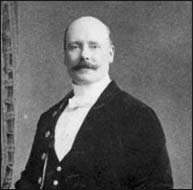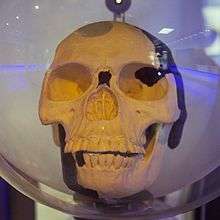Charles Dawson
| Charles Dawson | |
|---|---|
 Charles Dawson | |
| Born |
11 July 1864 Preston, Lancashire |
| Died |
10 August 1916 (aged 52) Lewes, Sussex |
| Cause of death | Sepsis |
| Nationality | British |
| Occupation | Solicitor |
| Known for | Piltdown Man hoax |
Charles Dawson (11 July 1864 – 10 August 1916) was a British amateur archaeologist who was initially credited with, and is now blamed for, discoveries that turned out to be imaginative frauds, climaxing with that of the Piltdown Man (Eoanthropus dawsoni), which he presented in 1912. Dawson was often present at finds in the archaeological digs, or was the finder himself.
Born the eldest of three sons, Dawson moved with his family from Preston, Lancashire to Hastings, Sussex when he was still very young. Charles initially studied as a lawyer following his father and pursued a hobby of collecting and studying fossils.[1]
He made a number of seemingly important fossil finds. Amongst these were teeth from a previously unknown species of mammal, later named Plagiaulax dawsoni in his honour; three new species of dinosaur, one later named Iguanodon dawsoni; and a new form of fossil plant, Salaginella dawsoni. The British Museum conferred upon him the title of Honorary Collector. For these important finds he was elected a fellow of the Geological Society and a few years later after another find, to the Society of Antiquaries of London in 1895. Dawson died prematurely from septicaemia in 1916 at Lewes, Sussex.[1][2]
Alleged discoveries

In 1889 Dawson was a co-founder of the Hastings and St Leonards Museum Association, one of the first voluntary museum friends groups established in Britain. Dawson worked on a voluntary basis as a member of the Museum Committee, in charge of the acquisition of artefacts and documents. His interest in archaeology developed and he had an uncanny knack of making spectacular discoveries, The Sussex Daily News named him the "Wizard of Sussex" for his success.[2]
In 1893 Dawson investigated a curious flint mine full of prehistoric, Roman and mediaeval artefacts at Lavant, near Chichester and probed in inner depths of two tunnels beneath Hastings Castle. In the same year, he presented the British Museum with a Roman statuette from Beauport Park, which was made, uniquely for the period, of cast iron. Other discoveries followed, including a strange form of hafted Neolithic stone axe and a well-preserved ancient timber boat.[2]

He studied ancient quarries, re-analysed the Bayeux Tapestry and, in 1909, produced what was then the definitive study of Hastings Castle. He later found faked evidence for the final phases of Roman occupation in Britain at Pevensey Castle in Sussex.[2] Investigating unusual elements of the natural world, Dawson presented a petrified toad inside a flint nodule, discovered a large supply of natural gas at Heathfield in East Sussex, reported on a sea-serpent in the English Channel, observed a new species of human and found a strange goldfish/carp hybrid. It was even reported that he was experimenting with phosphorescent bullets as a deterrent to Zeppelin attacks on London.
In recognition of his many discoveries, Dawson was elected a fellow of the Society of Antiquaries of London in 1895. At the age of 31, and without a university degree to his name, he was now Charles Dawson F.G.S., F.S.A. His most famous discovery was in 1912 with the discovery of the Piltdown Man which was billed as the "missing link" between humans and other great apes.[1]
Criticism
Questions about the Piltdown find were raised from the beginning, first by Arthur Keith, but also by paleontologists and anatomists from the Smithsonian Institution and from Europe. Those disputing the find were attacked in very personal terms. Challenges to Piltdown Man arose again in the 1920s, but were again dismissed. In 1949, further questions were raised about the Piltdown Man and its authenticity, which led to the conclusive demonstration that Piltdown was a hoax, in 1953. Since then, a number of Dawson's other finds have also been shown to be forged or planted.[2][3]
In 2003, Miles Russell of Bournemouth University published the results of his investigation into Dawson's antiquarian collection and concluded that at least 38 specimens were clear fakes. Russell has noted that Dawson’s whole academic career appears to have been "one built upon deceit, sleight of hand, fraud and deception, the ultimate gain being international recognition".[4]
In 2016, a team of British researchers used DNA studies to provide added evidence for the provenance of Piltdown Man. They concluded that Dawson likely acted alone, and was the only person in the group of suspected perpetrators with sufficient scientific knowledge to have carried off the bluff.[5]
Charles Dawson never received a knighthood, though many others associated with the Piltdown "find" did, and was never elected to the Royal Society. Following his death in 1916, no further finds were made at Piltdown.[2]
Notes
References
- De Groote, Isabelle; et al. (2016). "New genetic and morphological evidence suggests a single hoaxer created 'Piltdown man'". Royal Society Open Science. 3. doi:10.1098/rsos.160328.
- Russell, Miles (2004). Piltdown Man: The Secret Life of Charles Dawson (Revealing History). Tempus. ISBN 0752425722.
- Russell, Miles (2013). The Piltdown Man Hoax: Case Closed. The History Press. ISBN 0752487744.
- Shreeve, James (1995). Neanderthal Enigma. William Morrow & Co.
- Spencer, Frank (2004). "Dawson, Charles (1864–1916)". Oxford Dictionary of National Biography. Oxford University Press.
- Walsh, Evangelist John (1996). Unraveling Piltdown: The Science Fraud of the Century and Its Solution. Random House USA Inc. ISBN 0679444440.
Further reading
- Kendall, Martha (1970–80). "Dawson, Charles". Dictionary of Scientific Biography. 3. New York: Charles Scribner's Sons. pp. 606–607. ISBN 978-0-684-10114-9.
External links
- "Charles Dawson Piltdown Faker" BBC News
- Project Piltdown at Bournemouth University
- Archive of Piltdown-related papers at Clark University
- Annotated bibliography of Piltdown Man materials by T. H. Turrittin - See especially section 15 related to Charles Dawson
- Reevaluation of a supposedly Roman iron figure found by Charles Dawson, but later determined not to be Roman
- "Charles Dawson: 'The Piltdown faker'". BBC News. 21 November 2003. Retrieved 8 August 2008.
- Web pages and timeline about the Piltdown forgery hosted by the British Geological Survey
- "Piltdown review points decisive finger at forger Dawson" BBC News